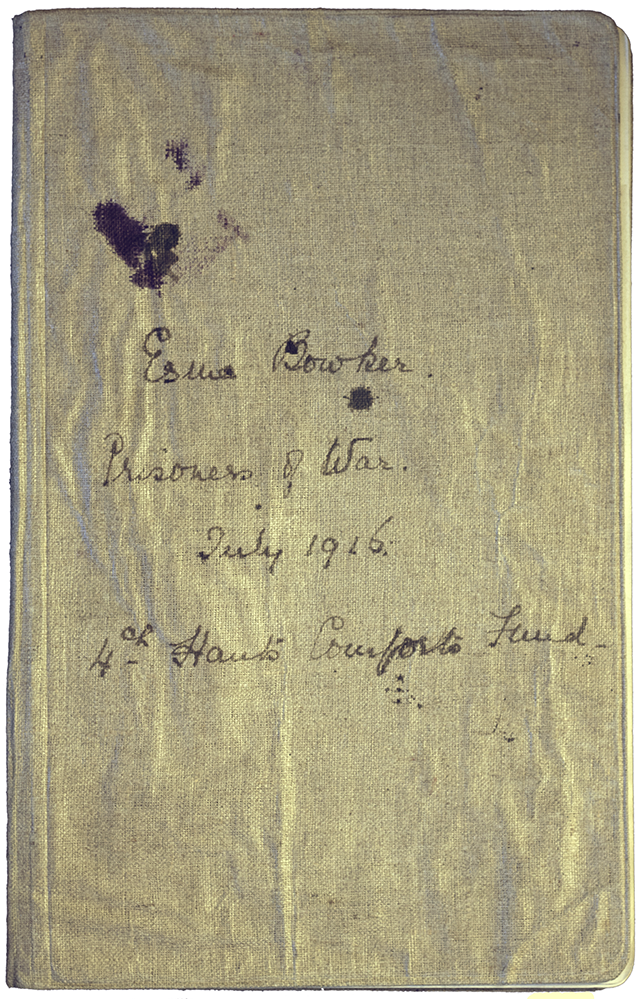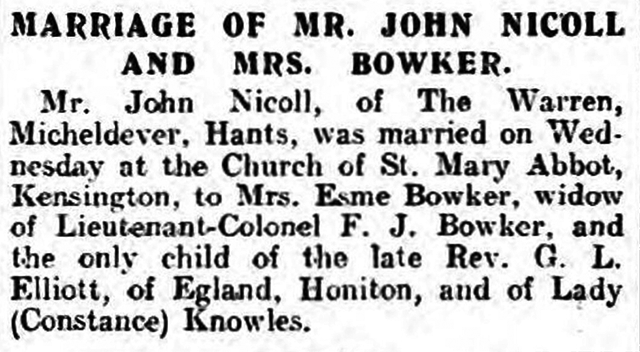
Mrs Bowker’s Comfort Fund
Mrs Esme Bowker was the widow of Lieutenant Colonel F. J. Bowker of the 1/4th Hampshire Regiment. Francis Jearrard Bowker was born in Paddockhurst, Sussex in 1868. He was educated at Harrow and Sandhurst. He had a distinguished military career, being promoted to the rank of Major before he retired from the army. He had seen service in the Boer War and was mentioned in despatches. In 1897 he married Esme Elliott,1 daughter of the Reverend George Elliott and Lady Constance Knowles. They married in Cairo where Francis was serving as ADC to Major-General Sir C. B. Knowles K.C.B. from October 1895 until August 1897. They had two children, Charles born in 1898 and James born in 1901. When war was declared Francis immediately re-enlisted in Winchester, and was given command of the 1/4th Territorial Battalion of the Hampshire Regiment. By September he was on his way to India, first to Poona and then to Rawalpindi. He arrived in Mesopotamia in March 1915 and was wounded at Nasiriyeh and presumably returned to Basra to recover while the rest of the Expeditionary Force continued their advance into Iraq, before eventually they were besieged at Kut. He was then able to join the Relief Force that had been tasked with reaching and relieving the besieged garrison at Kut-al-Amara. Lt Col Bowker died while commanding half of the 1/4th Hampshires at the Hanna Defile on 21st January 1916. The defeat at Hanna, with a particularly heavy loss of life from among the former students of Winchester Diocesan Training College, marked the end of the first attempt to reach Kut. In April 1916 the garrison at Kut, with no imminent expectation of help arriving in time, surrendered to the Turkish commander Halil Bey, and the soldiers who had survived the privations of the siege, were taken prisoner by the Ottoman Army. Worse was to follow as the members of the garrison were marched away from Kut and into captivity.
Mrs Bowker decided to do whatever she could to help those soldiers of the 1/4th Hants who had become prisoners of war of the Turks. Her ‘Comforts Fund’, which the front cover of this ledger suggests was set up in July 1916, is full of fascinating information. There are lists of the names of prisoners and their home addresses, and lists detailing where they were being held prisoner. Where possible she recorded the fate of the prisoners.
Mrs Bowker raised money to send parcels out to the prisoners. She did this by having each prisoner ‘adopted’ by someone in the U.K. So there are also lists of the adopters and their addresses. Finally, the ledger contains a record of the parcels that she sent to the prisoner of war camps.
The prisoners who were former students of Winchester Training College were Andrew Bogie, Charles Singleton, William Leach, and Frederick Bolwell.
From the pages of the fund ledger:
- Bogie A, QMS 149, 10 St Paul’s Terrace, Winchester
- Adopter: Stilwell, The Pines, Windlesham, Surrey
- Singleton CF, Pte 3084, The Lodge, Ashton Gifford, later in Codford
- Adopter: Harefield W, Vine Cottage, Tichbourne, Alresford
- Leach WF, Col Sgt 187, 1 Montgomery Rd, Bemerton
- Adopter: Bowker, Longparish, Hants
- Bolwell F, Pte 2167, 12 Woodboro Rd, Radstock
- Adopter: Hill, 84 Adelaide Rd, South Hampstead
It is interesting to note that Mrs Bowker was the adopter of William Leach. As he was a senior Non-Commissioned Officer she may have met him, or she may have heard her husband talking about him.
The Ledger tells us that Bogie was being held at Yarbaschi Camp and that he died there of dysentery in October 1916. Andrew Bogie actually died on 22nd September, but we have no way of knowing if Esme Bowker was recording the date that she thought he had died, or when she was informed of his death. Bolwell is recorded as having died at Baghdad on 5th May 1916, and beside Singleton’s name it simply says ‘died’, although a later entry records his death as being at Mosul. There is no camp listed for Charles Singleton. Our research has established that Charles died in Mosul, in the early stages of the march into captivity, having been left behind as he was deemed unable to continue the trek due to ill health. William Leach was recorded by Mrs Bowker with several camps beside his name; Afion Kara Hissar, Yarbaschi and Adano. He was the most senior officer amongst the men of the 1/4th Hants in captivity (Commissioned Officers having been separated off from the Other Ranks) and as such he was in a position of authority in the camps. He was allowed to travel between camps to deal with the welfare of the prisoners and was held in very high esteem by both the captives and their captors. His death from typhus was recorded as occurring at Nisibin.
There are personal details recorded in the Comforts Fund Ledger, presumably to assist in sending appropriately-sized clothing out to the camps. We learn that Andrew Bogie was 5 feet 10 inches tall, and that he wore size 9 shoes and a 6 ¾ inch cap. William Leach was the same height but wore size 8 shoes.

A list of parcels sent to the prisoners by Mrs Bowker begins in October 1916. The first parcel, sent on 1st October contained;
- Jacket, trousers, boots, shirt, socks, cap
- Overcoat, woollen pants, cardigan, socks
It is important to note here that these items were even more essential than it may at first appear. Most of the prisoners, on their long march into captivity, had lost basic items of clothing through theft or bartering for food.
Later that same month and into early November parcels of blankets were sent. As well as sending vital items of clothing, Mrs Bowker considered the soldiers morale and sent playing cards and books to each camp in October.
November saw Mrs Bowker sending a Christmas parcel to each man.

The parcel contained:
- Plum pudding
- 1lb bullseyes2
- Muffler
- 50 cigarettes
- 1/4lb tobacco
- pipe
- soap
- toilet paper
- gloves
- 3 handkerchiefs
- needle
- cotton
- shirt, socks mittens or bag
- boric powder or ointment3
- towel
Also in November, another parcel sent to each camp contained 1 dozen bottles of Angier’s Emulsion. This was first manufactured in the 1880s and sold world-wide throughout the mid-20th Century. It was first marketed as a ‘food medicine’ and as a cure for a variety of respiratory ailments. The main ingredient was refined petroleum oil which was later shown to have no nutritional value. In response the Angier Chemical Company reformulated the product and marketed it instead as a laxative. However, the idea that Angier’s Emulsion helped to soothe membranes, including those of the respiratory system, continued to feature in advertisements. It was also promoted to treat influenza and as a general cure-all.

Another parcel sent in November contained 2 footballs for each camp, and a gift from Mr Slade Baker allowed Mrs Bowker to provide each camp with 10 New Testaments. Mrs Bowker was able to send money to the prisoners with which they could purchase items from the local population.
As a final act of kindness Mrs Bowker arranged the welcome home reception for the prisoners who had survived. A Reception was held in the Guildhall in Winchester. The menu for the evening was supposed to be amusing, and surely the intentions were good but it is debatable whether all those attending would have been able to see the funny side:
ATTACK ORDERS
- Mule Tail Soup
- Roast (4th) Hampshire Hog
- Steak and Kidney Pie (Basra Flavour)
- Kut Grass, Roots etc
- Plum Pudding and Tigris Water Sauce
- Mespot Jelly
- Yesac Blancmange
- ‘Yallah’ Cheese4
Mrs Bowker was not alone in organising a Comforts Fund. These were set up all over the country by wives and widows, to provide much needed items to prisoners.
Esme Bowker re-married, in 1922, in Kensington London, to John Nichol. She died in 1973 at Wokingham, Berkshire.

Researcher and Author: Dee Sayers
Sources
Ancestry (2018). Home page. [online] Available at: www.ancestry.co.uk [Accessed 2018].
British Newspaper Archives (1922). Hampshire Advertiser – Saturday 25 November 1922, p.7. [online] Available at: https://www.britishnewspaperarchive.
co.uk/viewer/bl/0000495/19221125/
157/0007 [Accessed 2018].
Crowley, P. (2016). Kut 1916: the forgotten British disaster in Iraq. Stroud: The History Press.
Flikr (2014). Bradford Timeline: Angiers Emulsion. [online] Available at: https://www.flickr.com/photos/
bradford_timeline/14436334664/in/
photolist-nZFZkN-jPZ4F-iEBR4w-qjp
6JX-odPdhx-BKKPzR [Accessed 2018]
The William Leach Collection (Various). Records of RSM W.F. Leach including the records of Mrs. E. Bowker [documents, notebooks, photographs and artefacts] The Royal Hampshire Regimental Museum (Various), Winchester.
People for Clean Beds (2018). Boric Acid History. [online] Available at: http://www.peopleforcleanbeds.org/
boric_acid_history.htm [Accessed 2018].
A Virtual Tour of Pharmacy Artefacts (2014). Angier’s Emulsion. [online] Available at: http://pharmacy.wp.txstate.edu/
2016/07/04/angiers-emulsion/ [Accessed 2018].
Wikipedia (2018). History of wound care. [online] Available at: https://en.wikipedia.org/wiki/
History_of_wound_care [Accessed 2018].
- Esme was actually named Edith Sophie Mary
- Bullseyes were a mint flavoured boiled sweet
- Mrs Bowker’s handwriting is difficult to decipher here but after research a guess is that this is boric powder or ointment. Boric powder was widely used at the time as a mild astringent and a deodorant. It was also used as an insecticide and as a treatment for wounds.
- ‘Yallah’ is an Arabic word which translates roughly as hurry up or get going. It was constantly used, often with the application of physical chastisement, by the Arab guards assigned by the Turks to accompany the columns of prisoners on the long march into captivity after the surrender of Kut al Amara.
